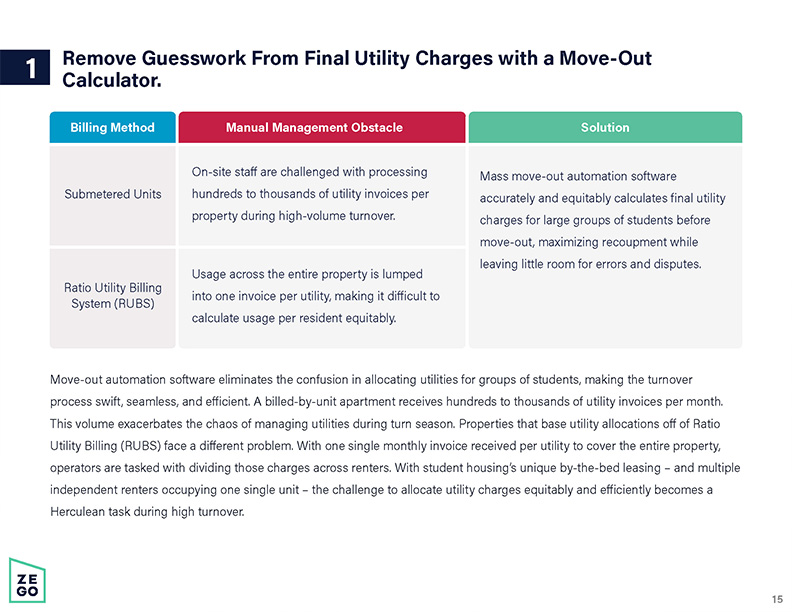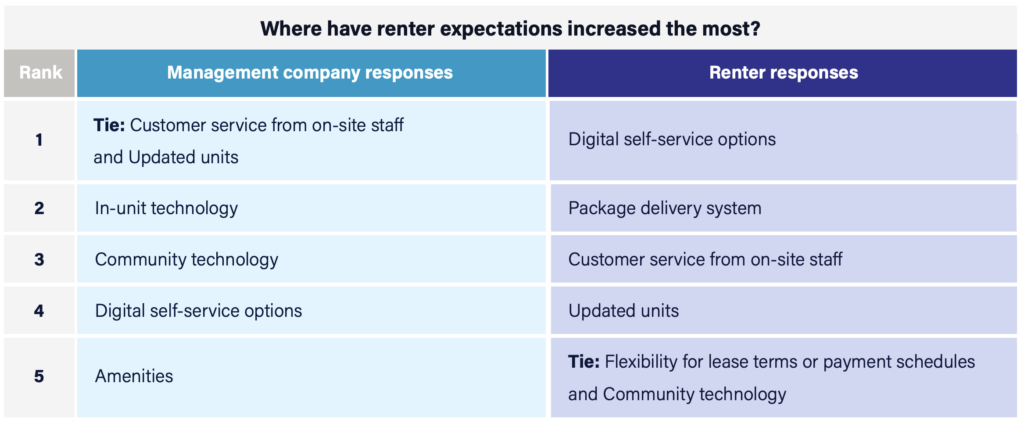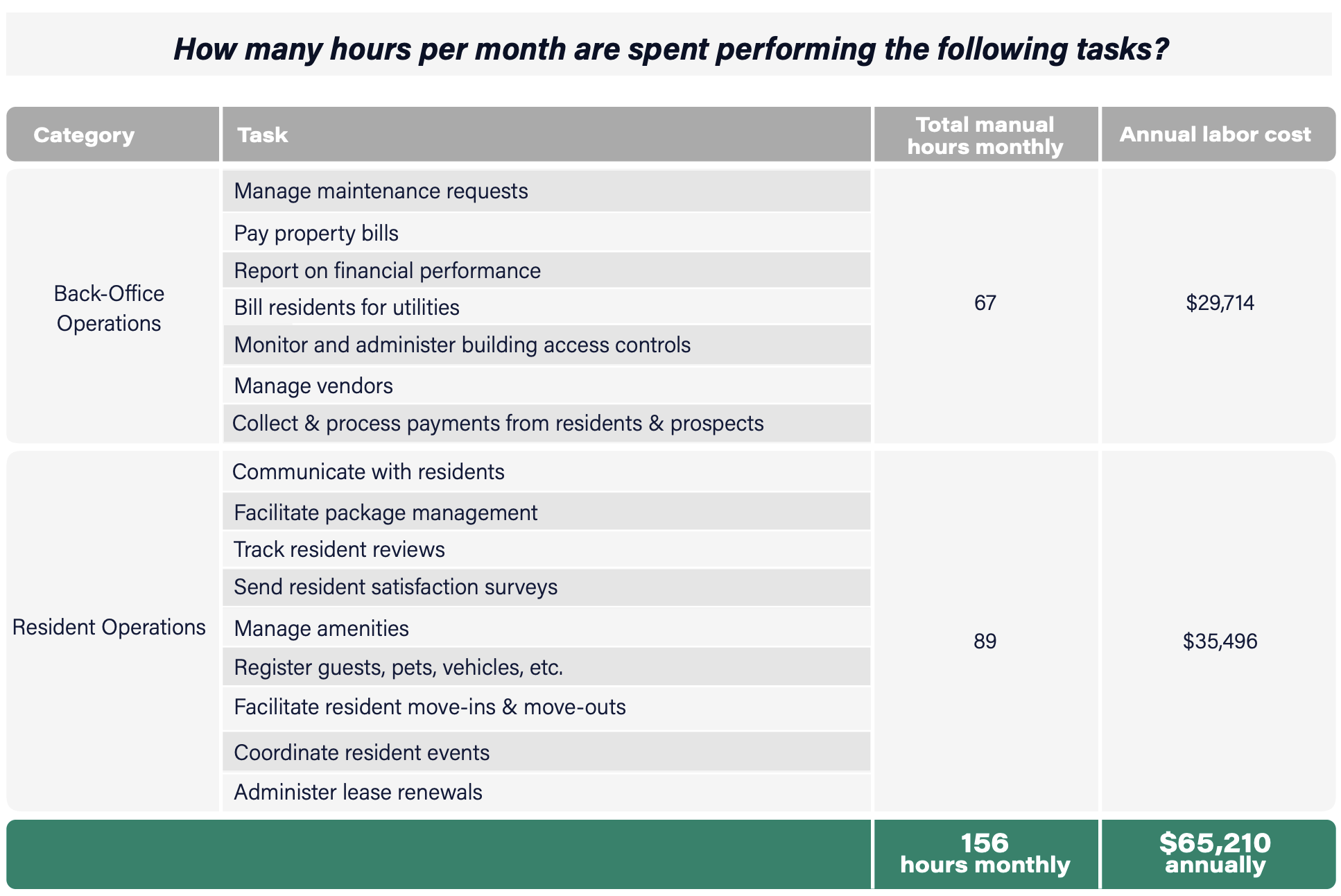Managing Student Housing: 7 Pro Tips to Improve Operations
An excerpt of this article was originally published by YieldPro
With its high rate of turnover and occupancy concerns, the student housing market remains a challenging niche within the real estate industry. In this article, learn about the unique preferences of young renters and unlock the best strategies for managing student housing.
Understanding Student Housing Residential Management
Purpose-built student accommodation (PBSA) is a type of privately owned residential complex designed to house university students off-campus. These properties come in a variety of forms including dormitories, co-ops, and apartments. As of 2022, the 5 largest student housing suppliers include American Campus Communities, The Scion Group, Harrison Street, Greystar, and Landmark Properties.
To handle operations effectively, owners often hire property management companies to help maintain and grow their communities. However, managing student housing presents unique challenges. It’s crucial to research student-specific tenancy and understand the current market conditions to develop a robust student housing management plan.
Recent trends in student housing point to a critical need for tighter operations in coming years. Experts remain wary of the incoming “enrollment cliff” – a dry spell in school enrollments marked by the drop in birth rates after 2008, according to Axios. This cliff raises concerns about student occupancy for future academic terms, spelling trouble for demand in the space. Coupled with a gradual decrease in pre-leasing rates compared to 2023 according to College House, the immediate future of PBSA demand doesn’t appear to be as strong as post-pandemic numbers.
Looking operationally, shortages in staff spell trouble for owners. Student Housing Insight’s episode ‘Turn Talk 2024’ mentions that one in four properties are short-handed, with many operators expressing concerns about retention. Expenses related to insurance and maintenance also remain volatile partially due to uncontrollable factors like weather.
Given slowing demand, student housing owners can expect competition for occupants through the next few years. This challenge coupled with temperamental costs and labor shortages signals the need for airtight operations. A robust plan will ensure steady occupancy, encourage staff and renter retention, and build net operating income (NOI).
Elevate your student housing management
Cater to the evolving demands of student housing, maximize utility cost recovery, streamline processes, and improve living experiences with Zego. Request a demo and see how Zego can help you can transform your properties.
Navigating Student Housing vs. Multifamily Properties
Due to its student-specific tenancy, a few key traits separate student housing from the multifamily portfolio. Distinctive features that impact how to manage student housing includes:
- “By the bed” billing structure
Unlike the typical rent structure of a multifamily complex where residents are housed per unit, many student housing properties choose to rent by the bed. In looking for affordable off-campus accommodation, students will opt to live with roommates in a dormitory-style or suite setup. This allows student housing owners to charge multiple rents per unit.
- Adjusted utility management
Student housing’s unique “by the bed” structure adds a layer of complexity to managing utilities. Determining how to equitably allocate usage can be challenging when one unit contains multiple tenants.
- Tech-based communication methods
With the vast majority of student tenants being a younger demographic, there is a different expectation of communication compared to multifamily portfolios. Students expect digital correspondence, with notifications and chat features reflecting their standard of ease and convenience.
- Student-specific amenities
Multifamily properties typically offer family-focused amenities due to its broad range of renter demographics. However, student housing communities cater more to the college experience. Apartment offerings might include study centers, wifi, social facilities, and more.
- Academic year lease cycle
Unique to this market, student housing operates its lease and billing cycle off the academic year. In this case, leases may last somewhere between 9-12 months. This differs from a multifamily leasing situation in which the property may offer contract terms more suited for a family.
- Co-signed leases
Student housing portfolios deal with more guarantors on leases than multifamily. It’s not uncommon for a student to ask their guardian or other adult to co-sign an apartment. This is because many college students are young adults with little to no financial experience and often require assistance to secure a lease. That said, guarantors add a layer of protection to rental payments for student housing owners.
Taking everything into account, managing student housing properties poses distinctive challenges that demand a customized approach. Effectively navigating the prerequisites for student housing can cultivate a positive community experience for residents while safeguarding your NOI.
Student Housing Management Challenges: 7 Strategies for Success
Now that we’ve explored student resident needs, we can better understand this market’s exclusive challenges and solutions. To do so, we should spotlight the demographic this portfolio type serves. A growing slice of the present-day renter market is made up of Gen Z, the generation born between 1997 and 2013.
With the youngest of this group reaching teenagehood and the oldest hitting their late twenties in 2024, this generation completely encompasses the age range making up the largest population of current-day college students, ages 18-24. That makes Gen Z the prime demographic for student housing.
With our resident audience in mind, let’s dive into seven common hurdles we see in student housing management and the strategies to overcome them.
- Communication breakdowns
- Lack of community engagement
- Frequent resident changes
- Outdated payment processes
- Time-intensive administrative tasks
- Utility billing confusion and disputes
- Overlooking sustainability initiatives


NEW RELEASE
The Ultimate Guide to Turn Season Utility Management
Written in partnership with Student Housing Insight, learn how to achieve a smooth and effective turnover process by focusing on one crucial aspect of operations: utility management. In this guide you’ll discover five utility management strategies that can positively impact revenue, conserve team resources, and enhance the resident experience.
1. Meet Student Renters Where They Are – On Their Smartphones
A 2023 study surveying over 2,000 American renters revealed that Gen Z and younger millennials have higher expectations around technology and communication channels. The survey found that 79% of renters look for a centralized communication solution that offers direct message, text, or chat options.
Zego’s 2024 Resident Experience Management Report further underscores the modern renter’s need for digital tools. In a survey of over 1,000 multifamily renters, “digital self-service options”, “customer service”, and “community technology” rank among the top 5 areas where renter expectations have increased the most.
Considering Gen Z’s standards around seamless and instant customer support and messaging, a robust communication strategy is vital in today’s student housing management efforts.

Strategy: As a manager of student housing, establishing clear communication channels tailored to student preferences will go a long way in easing friction.
The traditional way to engage a residential community – including bulletin boards, flyers, emails and phone calls – won’t be as effective in reaching young renters these days. Gen Z and Millennial tenants live on digital platforms. The best communication solution for a student housing property would be to leverage a resident mobile app.
Resident mobile apps help you easily deliver announcements, automate reminder texts or push notifications, organize community meetings, and facilitate conversations with residents. Features such as real-time chat and group messaging cut down response times. And a powerful dashboard enables on-site staff to reliably manage communication across the property.
Property managers and team members benefit from the lighter lift and improved efficiency, while student renters’ tech-based messaging standards are met.
2. Foster Community Connections
A unique aspect of student housing management is tenant interest in socializing with fellow students. Many students who choose to live in a residential community near school are eager to make connections.
This is a benefit for student housing managers who hope to curate an engaged, well-connected community, and also builds brownie points towards higher retention rates come turn season. While the demographic is ripe for community engagement, it can be difficult on the part of operators and staff to invent and facilitate regular social opportunities.
Strategy: Students expect regular social opportunities from their college communities. Student housing properties are no exception. Recognizing the unique interest students have in socializing with their peers, property managers should look to hosting community-building activities. This fosters engagement and feeds student needs for networking.
Luckily, there are resources available to help plan creative community events. This can include activities ranging from seasonal gatherings to movie nights and educational programs. With a resident app, facilitating these activities through announcement channels can be low-lift for on-site staff as well.
Another way to foster engagement is by connecting students to the community in which they live. Student housing is especially unique in that the majority of students are likely new to the area. One way to help facilitate community connection is by partnering with businesses in your property’s surrounding neighborhood to provide residents with exclusive deals and discounts.
Shops and restaurants are sure to offer student deals when in proximity to a college campus. Residential properties can work to compile a list of nearby deals and distribute them to residents. Local businesses benefit from the exposure while property managers enjoy higher resident satisfaction and a good working relationship with the surrounding area.
Overall, partnering with the neighborhood creates a more connected community. And a well-liked, well-connected student housing property is likely to attract and retain more renters.
3. Plan for Frequent Resident Changes
Student housing experiences an annual resident turnover event unlike any other portfolio type in the industry. Dubbed “the turn” or “turn season”, this annual interval between academic years marks the high-volume turnover of student occupants moving in and out. Like a wheel turning, students end their tenancy, leaving the door open for a new crop to begin theirs.
It’s the most stressful time of the year for student housing operators and can last weeks. That said, amid the chaos, this is prime time for leasing mistakes to slip through the cracks.
Strategy: There are a few tactics student housing managers can employ to prepare for the mayhem of turn season. Asset Campus Housing recommends planning early. Property managers should establish timelines, set deadlines, and allocate budgets well in advance to minimize last-minute chaos.
Additionally, clear and frequent communication with residents is paramount. This will help to provide transparency and dissuade resident frustration. Look for areas in your process that take the most time, and see if there’s potential to automate those tasks. This will be a huge time-saver for your team when turn-season comes around.
The truth is, that turn-season preparation is a year-long process. By working at resident satisfaction throughout the year, property management may see higher retention rates by lease-end. Lower turnover ultimately results in less stress during peak turn season.
4. Digitize the Payment Process
Payments and billing also have unique considerations that a typical multifamily residence does not encounter. As mentioned earlier, the average student renter is in their early 20s and lacks financial history and experience, significantly impacting the rental process. Many of them have little to no credit and therefore require a co-signer by way of a parent or guardian to help secure a lease. Not only are the parents or guardians co-signing the lease but they are also the ones making the payments on behalf of the student.
There is also the additional complication of “by-the-bed” leasing as student housing is often designed for a roommate(s) situation. All of these leasing nuances add complexity to the payment process that student housing operators need to manage.
Strategy: Understanding the special cases around student renters is paramount in ensuring both residents and property managers enjoy a seamless payment process. Taking into account the potential of a co-signer or guarantor, student housing management might employ a digital payment solution to streamline the rental payment process.
Digital payment portals allow residents and their supporters to review bills and manage payments easily. And by leveraging a digital solution, renter parties and property operators can also benefit from communication features. This allows for questions and requests to be processed efficiently, minimizing resident frustration and confusion.
By giving ownership and convenience of payments to both the renter and their support party, student housing managers safeguard their rents, increase resident satisfaction, and enjoy a streamlined, easy-to-manage system.
5. Automate Manual Administrative Tasks
In addition to streamlining rental payments as discussed above, there are other opportunities to minimize lift on student housing management. While the turn marks the year’s most chaotic season for student housing, on-site staff must still deal with maintenance requests, payments, billing, pulling reports, and other manual tasks throughout the year.
Managing these cumbersome processes is not only time-consuming. It’s expensive. When looking at multifamily property management, staff’s handling of back-office and resident operations throughout the year totaled a staggering 156 hours monthly and over $65,000 annually. While not specific to student housing, this data reflects the sheer amount of time and dollars spent on manual operations in property management.

Strategy: These days, it’s important to eliminate manual tasks that place strain on staff resources. This is especially crucial when turn-season comes around. During the busiest time of the year, staff find themselves facing a mountain of tasks while also addressing resident needs. This stressful balancing act leaves cracks in your team where mistakes can fall through.
The easiest way to combat unnecessary strain on your staff is by automating areas of your operations. From utility billing to communication barriers, much of the most tedious functions can be lifted off your team through the use of software and technology. We recommend you take note of your current workflow.
Find tasks that can be streamlined, such as payment processing, and research options for student housing properties. Continually accessing and adjusting your current processes allows you to automate where needed, freeing up time for your staff and protecting your property from ineffective operations.
6. Leverage Digital Tools to Streamline Utility Management
One of the most complex aspects of student housing is utility expense management and billing. PBSAs receive hundreds to thousands of utility invoices per month when submetered by unit, or one property-wide invoice per utility when using a Ratio Utility Billing System (RUBS). The sheer amount of manual processing required of on-site operators makes equitable and accurate usage allocations difficult.
Utility billing challenges arise within student housing due to this portfolio type’s unique addition of guarantors and by-the-bed billing. Implementing a cookie-cutter approach won’t be effective. Challenges can stem from an inability to allocate consumption fairly, irresponsible or unauthorized energy usage by students, and lack of billing transparency from the property, to name a few. For the resident, this can lead to confusion and frustration with their property management.
Strategy: We recommend that student housing managers automate the utility accounts payable and billing process. Whether using submeters or RUBS, student housing properties can streamline the cumbersome touchpoints of utility management using automation software.
A robust expense management system can automatically retrieve and audit invoices for you. This is helpful in identifying areas for recoupment and cost recovery, and also ensures student housing properties stay compliant and avoid penalties such as late fees. Billing can also be conveniently and accurately handled by automation software.
Student utility billing offloads the entire billing process for your team, from posting charges to your ledger to creating bills and notifying residents. Complex utility calculations can be automatically generated with mass move out calculators based on customizable formulas tailored to the needs of student housing properties. Plus, intuitive pay portals provide a level of billing transparency to renters and their guarantors. This helps to minimize disputes on utility charges and decrease the potential for confusion and disagreement.
A solid utility management system can automate all these processes for you, from calculating consumption to laying out charges. These personalized services ultimately help enhance utility operations by securing transactions, offloading manual lift, and identifying areas for cost recovery that help build NOI.
7. Prioritize Effective Sustainability Initiatives
Increasingly, modern-day students express concern about the environment and look towards institutions that practice sustainability. This expectation extends to their housing options. What’s more, poor sustainability not only negatively impacts the environment – it can damage revenue.
One common utility mistake we see student housing management professionals make is maintaining inefficient building features that encourage energy and water waste. With residential consumption up 10% in recent years and utility rates rising, this can be detrimental to NOI. Therefore, effective sustainability measures benefit both residents and property managers.
Strategy: Student housing managers should prioritize effective sustainability measures to address residents’ growing environmental concerns. The first step is identifying faulty building features that contribute to energy and water waste. These inefficient systems negatively impact the environment, but they also lead to lost revenue. Some solutions include installing energy-efficient appliances, water-saving fixtures, and implementing renewable energy sources where possible.
Additionally, encouraging eco-friendly practices to residents ensures everyone is doing their part. Property managers can implement community-wide recycling programs, offer educational events and activities, and open communication channels to discussion and feedback. Adopting sustainable measures positions your property as an attractive student housing option while saving you resources and revenue.
Elevate Your Student Housing Utility Management
By implementing these strategies, student housing management professionals can navigate the complexities of this market and provide positive and efficient living experiences.
In adapting to the preferences and demands of students, embracing digital automation solutions, and maintaining a focus on sustainability, property managers can plan for success in the ever-growing student housing landscape.
Offload utility management at your student properties
Zego’s student housing utility management solution helps you maximize utility cost recovery, improve accuracy, and gain visibility into portfolio-wide performance. Book a demo with Zego to learn more about solutions for utilities for student housing.